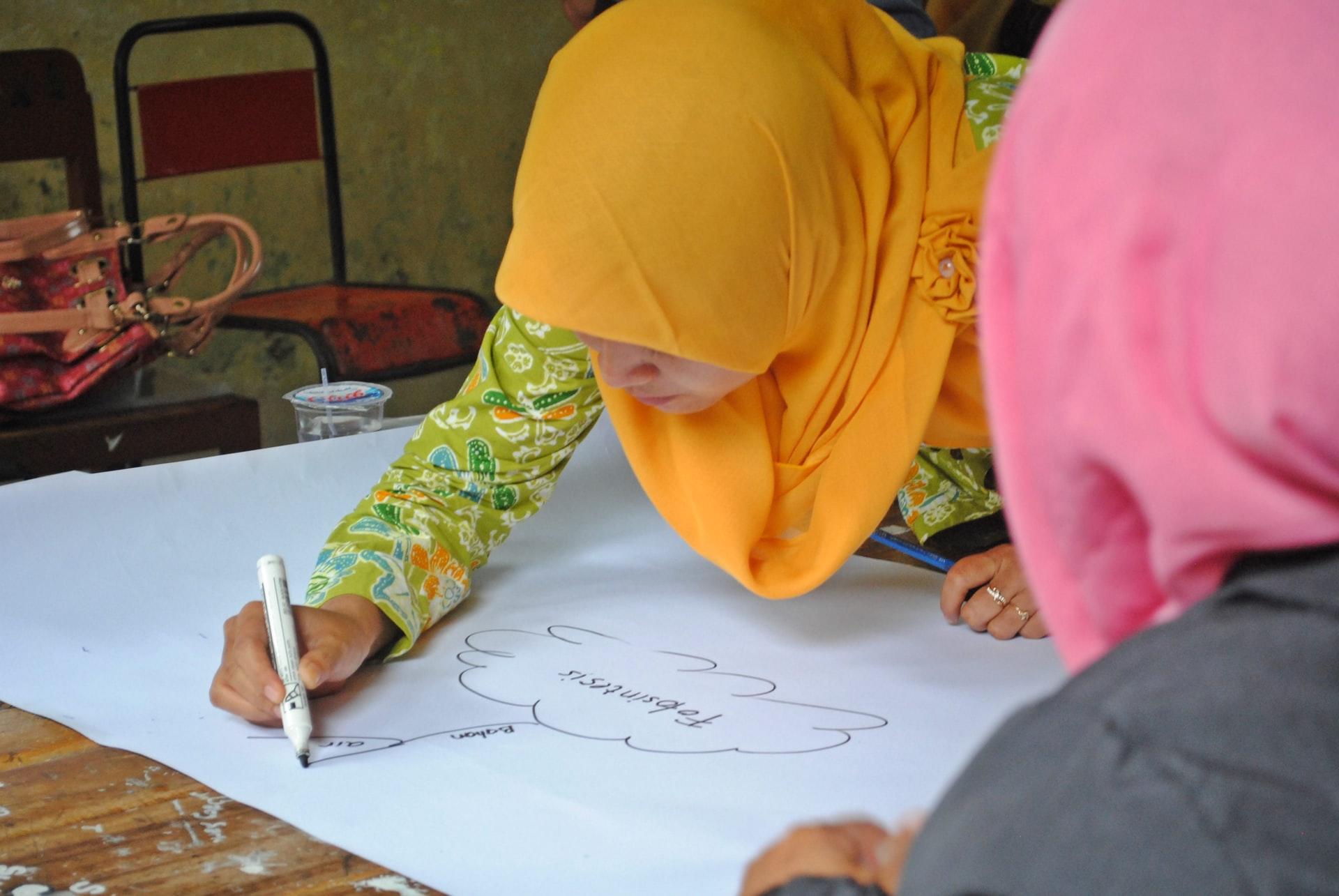Chapters
Over the summer months, after classes and on weekends during the school year, teachers moonlight as private tutors. Not only to make ends meet - teacher compensation leaves a lot to be desired, but also to try out novel teaching methods that they might not have time or ability to work into their classroom routine.
One such resource is learning maps. Deploying them in a large group setting poses distinct challenges, and not just because class time is so regimented. The danger is very real that teachers might not achieve the learning goals set forth on the map - or worse, that the map will be ignored.
We're getting ahead of ourselves, though. We need to know what they are to understand why using them in large groups is difficult.
- Learning maps are a 'begin with the end in mind' initiative
- they provide an overview of the study unit
- they highlight the relationship between different aspects of a study unit
- they are excellent tools for review and study
- they present what students should take away from each study unit
By this definition, you can see the trouble. If the subject you teach is... well, subjective like literature and art appreciation are, determining what your students should take away from your lessons could stifle rather than nurture their critical thinking skills. After all, teachers don't want to tell their students what to think; their job is to teach them how to think.
Still, many teachers and tutors recommend using learning maps (also known as thinking maps), especially those who teach The Sciences. For teachers who put in extra hours tutoring, creating learning maps during your tutoring sessions is an excellent way to trial the concept; to play around with them until you find the approach that works best with your pedagogy.
Are you looking for inspired teaching innovations? Are you willing to try something new in your lessons?
Let's help you get ready by making clear what learning maps are and why they are effective. We'll lay out different types of maps you could use and the specific purposes each one is designed for, and why you'll want to use them.

What are Learning Maps?
Going beyond the short, bulleted description in this article's introduction, let's expand what learning maps are: a visual tool used to show the different cognitive skills students normally employ when they approach a topic. These skills include:
- Defining in context
- Describing qualities
- Comparing and contrasting
- Categorising
- Part-whole - particularly effective for maths instruction
- Sequencing
- Cause-Effect
- Perceiving analogies
Again, we see how challenging this strategy could be to use in a classroom setting. Students display a variety of cognitive skills and each one has skills they are stronger in. How to select which skills to highlight?
On the other hand, if you build your map around the study unit's major themes and the knowledge and skills needed to uncover them, you would be on your way to building an effective learning map for group study. And then, if you follow that up by organising the lesson according to those three criteria - themes, knowledge and skills, you've drawn a map that your students can easily follow.
Side note: teaching is typically linear in nature. For example, students must first develop their numbers sense before they can understand how arithmetic works and they must be well grounded in principles of arithmetic before they can grasp the order of operations and solve for X.

Learning maps dispense with such rigidity. By beginning with the end in mind and making connections visual, students no longer have to struggle to 'get the point'. Your map will show the connections between the different elements presented in the study unit. According to students, seeing entire study units laid out in that manner is what works best for them.
You'll note that, throughout this segment, we mentioned study units rather than individual lessons. Drawing a learning map for an entire study unit is efficient and practical; doing one for each lesson is time consuming and ineffective because you won't cover enough ground in each lesson to make mapping it worth your or your students' while.
However, creating a learning map when tutoring is a different matter because, after you fill in the main takeaways, knowledge and skills, your pupils can flesh out the map with all that they've discovered between tutoring sessions.
Learning Maps and Effective Learning Strategies
Following extensive research and practical work, educator, Robert J. Manzano identified nine different learning strategies that strongly affect a student’s achievement in his collaborative work titled What Works in Classroom Instruction.
In it, he asserts that one of the best ways to put many of these strategies into effect both in the classroom and during private tutoring sessions is through the use of learning maps. These strategies include:
- Summarising and note-taking
- Cooperative learning
- Reinforcing effort and providing recognition
- Homework and practice
- Non-linguistic representations
- Setting goals and providing feedback
- Generating and testing hypotheses
- Identifying similarities and differences
- Activating prior knowledge
Naturally, you won't be able to or even need to deploy every strategy during every learning session. Likewise, some are better suited to one-on-one learning than to group learning. Still, this summary of methods serves to guide you as you incorporate learning maps into every situation.
Are you looking for online tutoring jobs UK? Click on the link to find the best opportunities.
How Are Mind Maps and Learning Maps Different?
People from all types of career fields are familiar with mind maps. They are tree diagrams which lead from one point of knowledge or perspective to another, with the desired result signalling the end of the map (and the effort). They are uniquely suited and widely used in business, particularly when brainstorming new ideas or concepts and monitoring their progress till actualization.
By contrast, learning maps start at the desired end and work backwards. They may take many forms (we'll look at the eight most common types in the next segment) and are generally not sequential, meaning they don't lay out a progression of ideas or a parade of information.
Learning maps and mind maps both have their uses in education. For instance, students preparing for college entrance exams should use mind maps to keep track of everything they have to revise and highlight aspects of their exam subjects they need to put special effort into mastering.
In contrast with mind maps, learning maps are meant specifically for education. They can be used to enhance aspects of a study unit such as the relationship between aspects of a discussion point and how those aspects influence other points of discussion. Furthermore, the strength and nature of their connections can be made visible both in the way they're drawn and the linking phrases used to identify them.
Remember that learning maps revolve around establishing the lessons' or study unit takeaways and identifying the skills and knowledge needed to successfully master the material. Conversely, mind maps start with an idea and record its progression till fruition.
That takeaway illustrates the most dramatic difference between learning maps and mind maps.

The Eight Types of Learning Maps
As made clear in the preceding segment, learning maps are not used to simply organise information. They are a whole new language that visually represents the way we think.
Just as we've laid out 8 ways to become a better tutor, there are eight types of learning maps. Let's go over each one together.
1. Circle Maps are used for defining in context.
This map comprises two circles: a small, central circle within a larger one. The tutor or teacher asks the student to write a key idea or topic into the central circle and to list everything they know about that idea or topic in the bigger circle. For example, the central circle may simply state the word ‘verb’; outside this circle, students may wish to list a series of verbs they know or discover during the tutoring session.
2. Bubble Maps are used for describing qualities.
This map comprises a central circle containing one key idea with various branches emanating from it that lead to a series of rectangles or circles, containing words that describe the key idea. For instance, the central circle may contain the words ‘qualities of a good tutor’. The shapes which branch out from this circle may contain the words ‘interesting’, ‘fun’, ‘caring’, ‘challenging’, etc.
3. Double Bubble Maps are used for comparing and contrasting.
This map looks exactly like its name would suggest: it comprises two main circles which are joined in the centre by more circles indicating similarities between them. On the outer sides of each main circle, a series of branches and additional circles emanate, showing aspects they do not have in common. Tutors might like to use this type of map to help students compare and contrast two famous novels or two athletes they admire.
4. Tree Maps are used for classifying and categorising
This map is similar in appearance to a family tree; it contains one main subject divided into main ideas and then into details. It is a way to organise information – for instance, a tutor trying to teach his student about unhealthy foods may divide this subject into the following main headings: processed foods, salty foods, sugary foods. Beneath these headings, they could ask the student to include examples of each.
5. Brace Maps are used for relating the part to the whole
This type of map is similar to a tree map, except that the focus is not just on classifying the parts of the map (i.e. where main and subsidiary ideas go), if not on showing the different parts that make up the whole. It is particularly useful in mathematics. For instance, it might be used to show that 3+2=5 (5 being the whole) or to divide a state into cities, suburbs, etc.
6. Flow Maps are used for sequencing.
Flow Maps are used to describe a sequence of events. It might be used to represent the different events that make up a story, to solve a mathematical problem or to show the life cycle of a butterfly…
7. Multi-Flow Maps are used for showing cause and effect.
In a multi-flow map, a central node (square or circle shape with a key situation/event inside) is connected to a set of boxes on the left (which reveal what caused the situation/event) and a matching array of boxes on the right (which show the effects of the situation/event). It might be used to reveal the causes and effects of a tsunami, for instance, or the causes and effects of adopting an anti-bullying stance at school.
8. Bridge Maps are used for seeing analogies and metaphors.
This map is used to reveal the relating factor in an analogy. It can be used in a variety of subjects, including mathematics and EFL (English as a Foreign Language). For instance, we can use it to teach synonyms: ‘kind’ is the synonym of ‘nice’ and ‘furious’ is the synonym of ‘enraged’.
What metaphor could we for and deciding how much to charge for your lessons?

How to use Learning Maps
It's all well and good to advocate for innovative teaching tools but we should probably give you a few pointers on how best to use them, shouldn't we?
Learning maps make for a great pre-writing activity. Just by looking at a student’s map, a teacher or tutor can assess whether or not the student understood key concepts and aims before they start writing their essay or summary. Additionally, most students find it very easy to complete a learning map.
These maps' versatility means they can be used by learners of all ages to master a broad range of subjects.
Because they are visual guides to the material being studied, they encourage students to focus. Tutors and teachers find them useful when working with students who have difficulty concentrating because they only need to direct students' attention to the map for them to find their focus again.
Learning maps encourage students to use higher order/critical thinking skills rather than passively absorb knowledge. Or worse, blank out during the lessons. Students do not just use these maps to represent information or improve memory retention; they also use them to comprehend and assess how they are thinking. This process encourages reflective, independent learning.
These maps, when judiciously used, promote clarity of communication. In this respect they are like mind maps; they can be used to synthesise large quantities of information by encouraging students to identify key concepts and arguments.
Although you, the teacher/tutor will initiate their creation, learning maps are student-centred. Among their advantages, they promote cooperation, especially when jointly created by students in a group tutoring session or classroom.
Again, it's advisable to experiment with learning maps before you debut them in a large group setting.
If you already practise differentiated learning, for example, or if your class does mainly group work, you might pilot the idea with one or two student groups. If you tutor, especially outside of your work in the classroom, you'll have more latitude to trial learning maps and discover the types of maps that work best for you, your subject matter and your curriculum's stated goals.
Learning maps are just one of ten things you should take into every lesson; now discover what the other nine are.




















